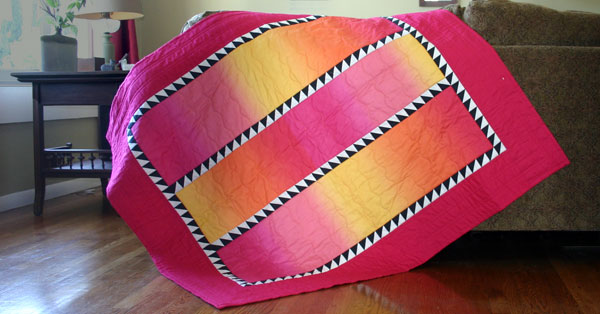
What’s as easy as one, two, three? It’s a quick-and-easy Sashing Stash “One-Two-Three” quilt! These speedy quilts have the advantage of being simple enough for beginners while catering to the sophisticated who want to show off their most fabulous fabrics (and maybe quilting) to maximum advantage.
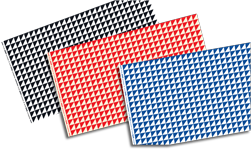
Sashing Stash Half-Square Triangles Motif
- Ombrés and hand-dyed fabrics
- Toiles
- String blocks, real or “fake,” or any leftover blocks
- Jumbo prints
Using an Ombréd or Hand Dyed Fabric
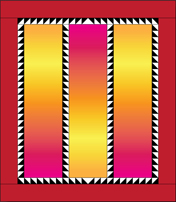 Maybe you’re a passionate dyer with shelves full of your creative work. At the very least, there’s probably one special piece you couldn’t resist buying, but now it sits there, a waif awaiting a splendid debut.
Maybe you’re a passionate dyer with shelves full of your creative work. At the very least, there’s probably one special piece you couldn’t resist buying, but now it sits there, a waif awaiting a splendid debut.
The small ombré quilt in the photo above was made with a commercial fabric where the repeat must be printed from side to side, a maximum of 42 inches. To create the length needed for this little quilt, panels the width of the fabric were split in the middle and the two dark borders or light borders sewn together to form the center of each panel. For a larger quilt with a single ombré traveling the height of the quilt, you’ll need hand dyed fabrics.
Toiles
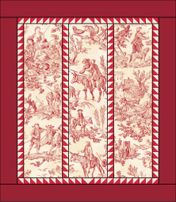 Workshops with titles like “What to Do with Those Great Fabrics You Bought and Now Don’t Have a Clue What to Do With” invariably draw a lot of stymied quilters. I’ve been to several and noted that at least a third of the students brought gorgeous toile fabrics that they bought on long-ago trips to Europe. Some students had guarded these treasures for decades, never wanting to cut them into little pieces.
Workshops with titles like “What to Do with Those Great Fabrics You Bought and Now Don’t Have a Clue What to Do With” invariably draw a lot of stymied quilters. I’ve been to several and noted that at least a third of the students brought gorgeous toile fabrics that they bought on long-ago trips to Europe. Some students had guarded these treasures for decades, never wanting to cut them into little pieces.
Now you don’t have to! Display them as they were intended, in large panels, appropriately framed. NOTE: If your toile colors aren’t friendly with the basic Sashing Stash colorways, check out what you can do with overdyeing. See also Taming Your Toiles with Sashing Stash.
String (or Any Leftover) Blocks
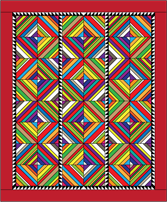 One of the most joyful and useful workshops I ever took was how to make quick string blocks on a newspaper foundation. You can get the same dramatic effect almost instantly with a lively multicolored stripe.
One of the most joyful and useful workshops I ever took was how to make quick string blocks on a newspaper foundation. You can get the same dramatic effect almost instantly with a lively multicolored stripe.
Jumbo Prints
If you’re anything like me, you sometimes fall irretrievably in love with a huge print, buy it, than end up using it on the back of a quilt years later. I plan to pick some of my really terrific current jumbo prints and show them off in One-Two-Three! Quilts. You can pull a great jumbo print from your own stash and start auditioning Sashing Stash frames.
Instructions
- Decide what your goal is for size. This will be dictated by either or both of the following:
- Best way to display fabric. That is, the size needed to show off the repeat or design elements to maximum effect. For example, the central panel should be wide and long enough to create a balanced and complete image, one you might frame and hang on you wall. This doesn’t mean you have to use all the design elements. Just crop into a seductive vertical panel. The two side panels (or possibly four for a queen- or king-sized quilt) can be direct continuations of the central design or cut from different parts of the fabric or even mirror images if the repeat makes that possible.
- Best size for final use. If you need a king-sized bed quilt or a baby quilt, choose a fabric that best fills the spaces in your 3- or 5-paneled “screen.”
- Audition the 5 different Sashing Stash strip motifs to see which is best for your fabric in terms of scale and geometrics. The Half-Square Triangle motif is generally the most versatile, but one of the others may work as well or better. Note that both “right-facing” and “left-facing” Half-Square Triangles are offered in the Sashing Stash focus fabric. The overall yardage provides one in strips cut on the length of the fabric and the other in strips cut across the fabric. (Remember that vertical strips won’t stretch, while horizontal strips have a slight stretchiness, so guard against over stretching the horizontal-cut strip when pairing two mirrored strips.)
- Audition the 3 colorways (black, red, blue). If none seem to work well, check out other Sashing Stash color possibilities in overdyeing.
- Figure the overall measurements of your panels, the Sashing Stash strips, and borders so you get the size you want. Keep in mind that each unit in this Sashing Stash design in 1.5 inches square. If you want your vertical bars to line up with a half-square triangle unit in the horizontal top and bottom strips of Sashing Stash, and if you want to have the Sashing Stash strips begin and end with a complete half-square triangle unit, your panels must be a multiple of 1.5 inches finished width and length as well. Use graph paper or a calculator. Double check your measurements against the measurements of the actual fabric before cutting, as variation in the printing of the fabric is possible.
- You may or may not care how the design comes together where the Sashing Stash strips join (abut) at the outside corners and where the vertical bars run into the bottom and top crossbars. It is possible to plan how the design comes together in many cases. See the Turning Corners page for some possible solutions. Or, just let it fall where it happens! There is no wrong way to do it.